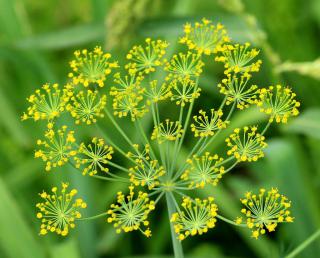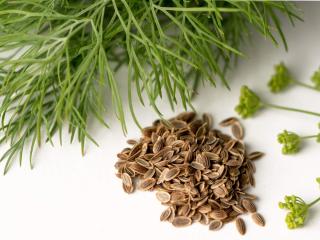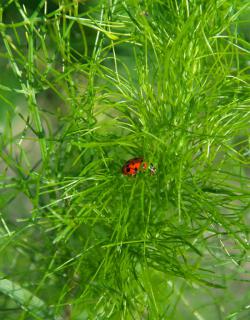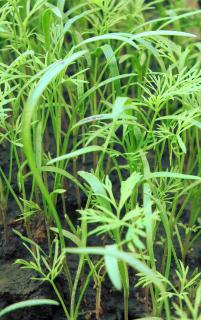

Dill is delicious with its delicate aniseed-like flavor and it is perfect paired with sauces, marinades and fish.
Important Dill facts
Name – Apium graveolens
Family – Apiaceae (parsley family)
Type – herb plant, annual
Height – 20 to 24 inches (50 to 60 cm)
Exposure – full sun
Soil – ordinary, rather light
Flowering – July to September
Harvest – June to September
Growing it is easy and care is reduced for a harvest all summer long.
 Dill is an easy plant that isn’t very demanding. This will make it possible for you to harvest its little leaves until late in the season.
Dill is an easy plant that isn’t very demanding. This will make it possible for you to harvest its little leaves until late in the season.
Position the plant so that it doesn’t overshadow other herb plants you might be growing, because it reaches a height of about 3 feet (1 meter).
 beginning of summer.
beginning of summer.→ Dates for sowing and planting dill by the moon
 Required care is down to a bare minimum, which is to say simply water when the ground is dry.
Required care is down to a bare minimum, which is to say simply water when the ground is dry.
Cut the leaves just before the plant flowers. The leaves from the parts of the plant are ideal to flavor mixed salads, sauces and marinades.
You can also use and eat the tiny seeds that appear at the end of summer to flavor your meals, or mix them into your salt dispenser to give your salt a special flavor.
Dill LOVES growing together with:
Broccoli, savoy cabbage, Brussels sprouts, cauliflower, cucumber, pickle, coriander, lettuce, turnip, onion and tomato.
Dill DREADS growing together with:
Absinthe, carrot, fennel, parsnip, parsley.
 Reminiscent of aniseed, this finely flavored herb called dill also has the advantage of being very simple to grow.
Reminiscent of aniseed, this finely flavored herb called dill also has the advantage of being very simple to grow.
Whether fresh or dried, it is perfectly suited to most dressings and sauces, fresh cheese, fish and shellfish, and even grilling seafood on the barbecue.
Its leaves are as thin as needles, quite similar to those of fennel, and its yellow-colored flowers evolve to produce delicious seeds at the end of summer.
Although only the species called Anethum graveolens grows in farms, it comes in a range of interesting varieties: ‘Dukat’, ‘Fernleaf’, ‘Hera’, ‘Mammoth’ and also ‘Tetra’.
If a pot is where you want to grow dill, get a hold of the ‘Fernleaf’ variety which is a dwarf variety: it will remain smaller than 16 inches (40 cm) tall.
Dill fears neither sun nor heat. It can thus be sown and planted in very exposed spots.
Just remember to keep it well watered or it’ll bolt, depriving you of fresh green leaves.